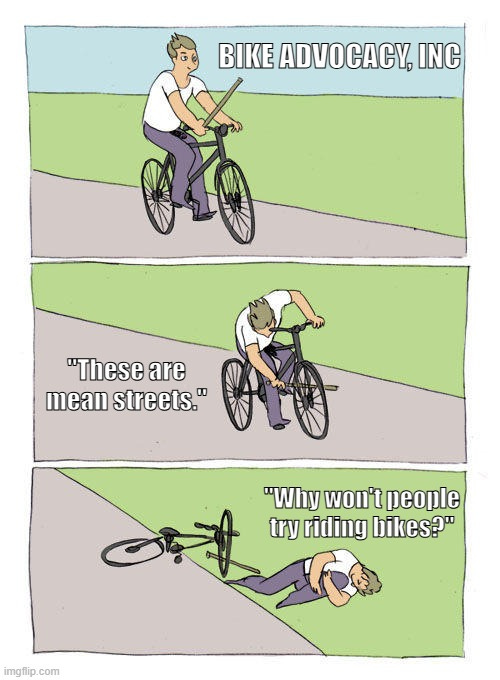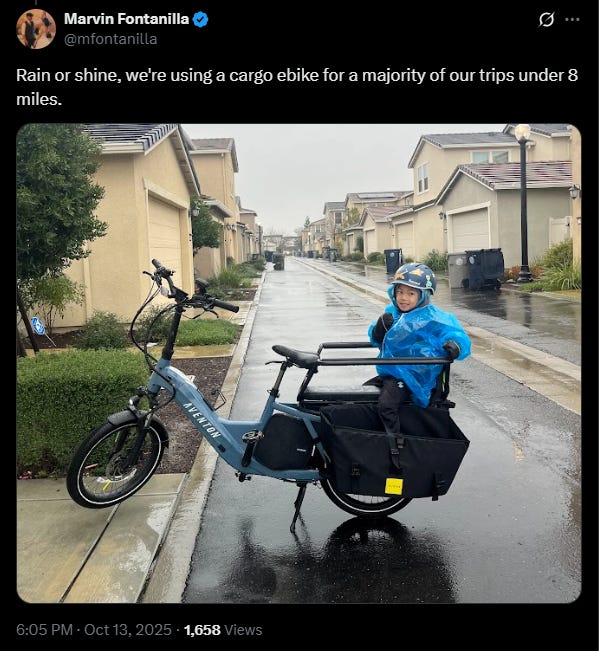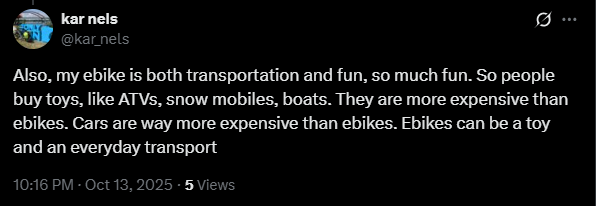Bike advocacy is putting a stick in its own spokes
But like most things, it's fixable. Things can get better in the end.
Do you want people to use bicycles for transportation or don’t you? In American bike advocacy, there’s a persistent echo chamber of despair: this street looks deadly, that street looks deadly, every street looks deadly.
It’s a messaging strategy that’s become so ingrained, and it leaves everyday folks who might be eyeing their bikes with mild curiosity shrugging and reaching for the car keys instead. Sure, they’ve thought about using a bike for some of those short errands close to home, but why take the risk since the local pro-bike advocacy group is convinced riding those streets is a death sentence.
I routinely post on social media about the horrors of modern infrastructure and the ways in which planning and transportation departments make life miserable for people who want (or need) to use a bicycle to get around town. So you might be scratching your head, wondering if this account has been hacked. It’s still me, the decrier of the American junk infrastructure that harms tens of thousands every year.
Bike Advocacy, Inc. is absolutely correct that most of our built environment does not fit who we are as humans. For most of the 20th century, “bike infrastructure” wasn’t even a phrase, so of course transportation networks across the country need improvements. The big mistake that so many bike advocacy organizations are making is failing to realize they have two audiences that need two very different messages. They need to appeal to donors, who make the operation possible. And they need to appeal to ordinary people, so they can demonstrate to donors that they’re helping to change culture.
The people who write checks need shock-and-awe messages related to politics and policy. But normies need inspirational messages related to practical ways to improve their daily lives.
An Instagram post showing a mangled bike frame next to a highway is the kind of gut-punch that prompts a philanthropist to donate. And that funding keeps the lights on at bike advocacy nonprofits. But that tactic is a total buzzkill for the average person just trying to figure out if biking to get bagels is worth the hassle. The message that gets one person to give money to improve bicycling as transportation will get another to give up on bicycling as transportation.
Whether a nonprofit is a staff of one or a few dozen, they’ve got to deliver the right messages to their very different audiences. Here’s a sample of what bike advocacy should focus on with the general public:
Encourage members to take a friend on some short bike rides to do fun things (concert, lunch, happy hour, birthday card shopping).
Organize fun group rides for neighbors. It could be as simple as a slow ride on a school night that ends at a favorite ice cream spot.
Invite local e-bike owners to a weekend talk about how they’re able to switch car trips to bike trips. This helps demystify the two-wheeled minivan that’s selling like hot cakes.
Celebrate new bike lanes all over social media. (If your local advocacy group needs some inspiration, there are over 100 agencies who participate in National Association of City Transportation Officials, regularly sharing success stories.)
Teach people how to share their personal stories related to using a bike to get around.
In everything you do with the general public, spread hope and smiles.
Bike infrastructure has dramatically improved over the last 15 years. My city will have added about 100 miles of bike lanes in 10 years. People are riding more and discovering all the calm neighborhood streets that are pleasant for all ages and abilities.
Things can get better in the end. But not if bike advocacy is nonstop banging a drum that riding bikes is a death sentence. Get people outside on bikes in places where it’s already safe. Pretty soon, the people will demand better infrastructure from their local leaders.






Bicycling on the sidewalk is a great choice. It's legal in Seattle and the state of Washington. It should be legal every place. I'm 79 years old and bicycle about 3 miles per day. No longer drive - committed to minimizing greenhouse gas emissions. Https://greenbetween.home.blog.
You make an interesting point, but in its weakest form, what you're saying is "Some of y'all are gonna have to put your bodies out on the streets and accept the risk that you'll pay the price (by being run over), because otherwise we'll never reach critical mass and teach drivers to anticipate seeing bikes on the street".
I think that's a significant weak form.
To play the devils advocate, Im much more in favor of strategies that actively prioritize minimizing injuries and deaths to cyclists. Two strategies that do that, are:
1) "critical mass" events where cyclists cannot be overlooked because there's just too many to miss.
2) infrastructure around care trips for parents with small children. Ie. safe bike infrastructure around kindergartens, and the nearest shops/parks/homes. This can be literally just half a mile of safe infrastructure as a start. This is a very sympathetic cause - its children and parents! After that the network can expand, where its only in the long term that commuters are prioritized. Thats basically what they did in the Netherlands. Its slow, its incremental, but I think it's a remarkably robust strategy.